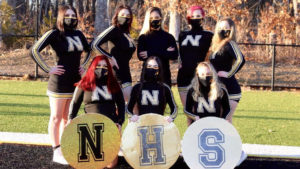EASTHAM — “Get in shape to play your sport — not play your sport to get in shape.” That’s something Michelle Pavlu, the head athletic trainer at Nauset Regional High School (NRHS), learned years ago from her mentor. It sums up the essence of the athletic training program at NRHS today.
Pavlu has been the Nauset trainer for 18 years, and, over the last decade, she’s seen a shift from a treatment-based to a preventive approach to health and fitness. That means a growing focus on preventing injury and illness rather than diagnosing and treating. The opioid epidemic prompted a deeper look into the use of opioids by athletes recovering from surgery.
“From a preventive medicine standpoint, there’s no one answer,” Pavlu said. But part of the answer is emphasizing strength and conditioning, along with education on injuries like concussions.
Bruce Strunk, Nauset’s football coach, is also the strength and conditioning coach. That job comes with extra pay, uncommon at the high school level. Strunk has 30 years of coaching experience and he works closely with Pavlu on preventive and rehabilitative training for students.
Strunk said he feels fortunate to have been exposed to preventive training early in his career. Strunk and Pavlu both encourage students to play multiple sports, because it’s common for students to suffer overuse injuries from training for and playing one sport throughout the year. Playing multiple sports helps.
Instead of training for a particular sport, student athletes focus on strength, speed, agility, and stability training, working to stay healthy and uninjured.
Nauset coaches take a comprehensive approach to athletic training and education, offering summer morning training, physical education classes that include a strength and conditioning course, and training before school (pre-Covid). The school even offers a yoga class during the school day.
Students in the strength and conditioning class can be athletes training for their sport or students who just want to learn about getting in shape. All students in the course benefit from collaboration among their coaches and Pavlu.
These types of programs vary from school to school, depending on financial constraints and what school districts view as important to teach athletes. Pavlu and Strunk both said that Nauset is fortunate to have the financial resources, staff, and knowledge base to provide the athletic and physical education programs it offers.
Having a full-time trainer on staff is important for students recovering from surgeries and injuries, too. They can continue to train with a plan tailored for them with the coordinated support of Pavlu and their coach.
That structure was important for senior cheerleader Lily Anderson of Eastham, who said she didn’t take concussions seriously until she experienced one herself and needed physical therapy. After Pavlu explained the gravity of her injury to her, and offered guidance on recovery, Anderson realized that her decision to compete immediately after the concussion left her with long-term effects.

Anderson cheered throughout her four years at Nauset and had multiple injuries. She broke her ankle twice and “pulled all the muscles” in her back, she said.
During recovery from her injuries, Pavlu and Anderson’s coach provided her with a plan. Anderson said they made sure “I was giving my body enough time to do what I needed to do.” When she was finally able to resume training and competing, they checked in with her to be sure she didn’t rush things.
Pavlu said she thinks athletes should avoid specializing in a sport too early. Part of having a successful athletic program comes down to having a “well-rounded, knowledgeable coach who can write a knowledgeable program,” she said.
One result of Nauset’s comprehensive approach to athletic training is that, when students graduate and compete at the collegiate level, the training regimens are “less of a shock.”
The head trainer said there was a greater disconnect between high school and collegiate programs when she first started at Nauset. In the early 2000s, “the idea of having a strength and conditioning program at the high school wasn’t there,” she said.
Opportunities to play in college have also increased with the growth of Division III athletics.
Whether focusing on helping athletes recover, training them to protect themselves from injury, or helping students meet their personal fitness goals, Pavlu and the other athletic staff try to provide individualized attention to all students.
“At Nauset, we’re not just focused on our student athletes,” she said. “We’re focused on our entire student body having access to strength and conditioning.”
